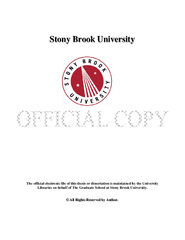| dc.identifier.uri | http://hdl.handle.net/11401/77750 | |
| dc.description.sponsorship | This work is sponsored by the Stony Brook University Graduate School in compliance with the requirements for completion of degree. | en_US |
| dc.format | Monograph | |
| dc.format.medium | Electronic Resource | en_US |
| dc.language.iso | en_US | |
| dc.publisher | The Graduate School, Stony Brook University: Stony Brook, NY. | |
| dc.type | Thesis | |
| dcterms.abstract | Quahogs, or hard clams (Mercenaria mercenaria) are an economically important species of clam. They are often used for human consumption, but can also be indicators of water quality because of the bioaccumulation of contaminants within filter feeders. They are found abundantly on the east coast of the United States and Canada, and actively aquacultured from Massachusetts to Florida. The hard clam is a robust species with few naturally-occurring diseases. The most well-known disease of the hard clam is Quahog Parasite Unknown (QPX), a unicellular parasite found on the east coast of North America from Virginia up into Canada, causing well-documented mortality events. Though the presence of QPX disease has been documented since the 1960s, little information is available on cellular and molecular interactions between the parasite and clams. This research project targets the interactions between the clam immune system and QPX cells. The clam immune response to QPX consists of an inflammatory response that often involves the encapsulation of the parasite by clam immune cells, or hemocytes. This research identified the clam plasma proteins involved in the initial immune response to QPX and evaluated the role of plasma proteins in initiating the encapsulation response. The effect of exposure of clams to QPX on encapsulation rate and on the expression of plasma proteins that bind parasite cells was also determined. Results allowed the identification of proteins that recognize and bind parasite cells, providing molecular targets for future investigations of factors involved in clam resistance to the disease, and ultimately for the selection of resistant clam stocks. | |
| dcterms.available | 2017-09-20T16:53:30Z | |
| dcterms.contributor | Allam, Bassem | en_US |
| dcterms.contributor | Collier, Jackie | en_US |
| dcterms.contributor | Pales Espinosa, Emmanuelle. | en_US |
| dcterms.creator | Hartman, Rachel | |
| dcterms.dateAccepted | 2017-09-20T16:53:30Z | |
| dcterms.dateSubmitted | 2017-09-20T16:53:30Z | |
| dcterms.description | Department of Marine and Atmospheric Science | en_US |
| dcterms.extent | 52 pg. | en_US |
| dcterms.format | Application/PDF | en_US |
| dcterms.format | Monograph | |
| dcterms.identifier | http://hdl.handle.net/11401/77750 | |
| dcterms.issued | 2016-12-01 | |
| dcterms.language | en_US | |
| dcterms.provenance | Made available in DSpace on 2017-09-20T16:53:30Z (GMT). No. of bitstreams: 1
Hartman_grad.sunysb_0771M_13159.pdf: 935812 bytes, checksum: 70fed20e1ebecd7988aca4f8bf2e261c (MD5)
Previous issue date: 1 | en |
| dcterms.publisher | The Graduate School, Stony Brook University: Stony Brook, NY. | |
| dcterms.subject | Molecular biology -- Parasitology | |
| dcterms.subject | Clam, QPX | |
| dcterms.title | Investigating cellular and molecular interactions between the hard clam (Mercenaria mercenaria) and its pathogen Quahog Parasite Unknown (QPX) | |
| dcterms.type | Thesis | |

